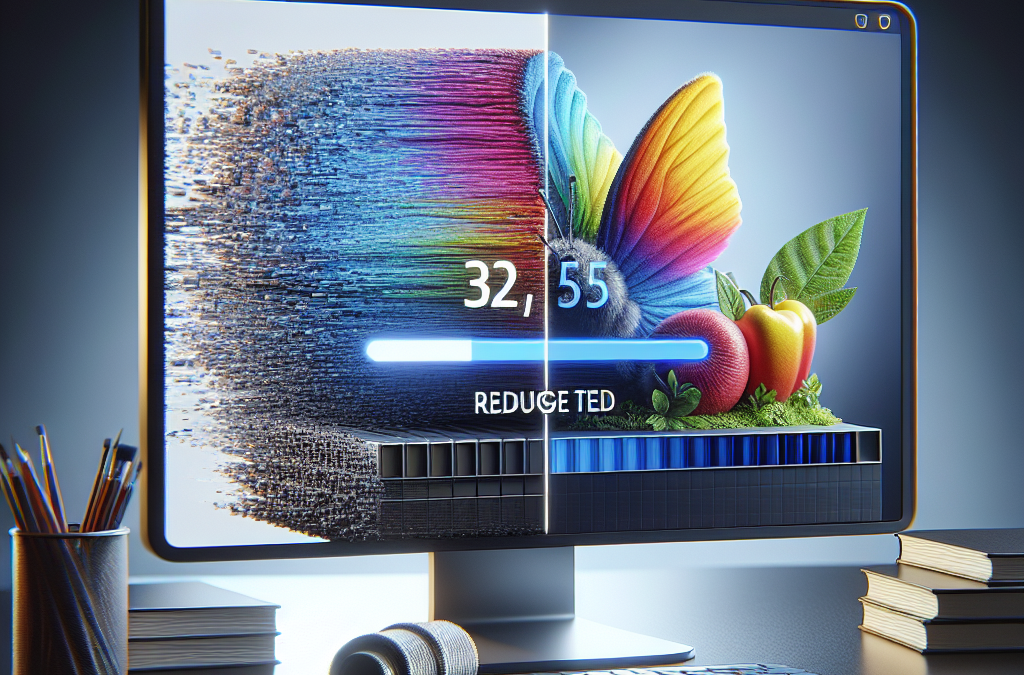How to Optimize Images for Faster Loading Websites
Introduction
To enhance your website’s performance, it’s essential to Optimize Images for Faster Loading Websites. In today’s fast-paced digital environment, the speed of your website can significantly impact user experience and engagement. A staggering 53% of mobile users abandon sites that take longer than three seconds to load, highlighting the urgent necessity for businesses to focus on strategies that improve loading times. This is particularly true for creative agencies like eDesignerz.com, based in Salem, Oregon, which specializes in web design and development. With over 27 years of experience, eDesignerz understands how crucial it is for their clients to have a website that not only looks great but functions efficiently.
Recent studies have shown that image optimization plays a vital role in determining a website’s loading speed. In fact, images often account for over 70% of a webpage’s total size, thus making their optimization a key factor in enhancing performance. When images are properly optimized, they can load faster, leading to lower bounce rates and higher user retention. Additionally, optimized images improve SEO rankings, as search engines prioritize websites that provide a better user experience.
In this article, we will explore effective techniques for image compression, the importance of choosing the right formats, and the tools available for optimizing images. Whether you are a business owner or a web designer, understanding how to Optimize Images for Faster Loading Websites can lead to a more successful online presence.
What is Optimize Images for Faster Loading Websites?
Definition
Optimize Images for Faster Loading Websites refers to the process of reducing the file size of images without compromising their quality. This involves various techniques and strategies aimed at ensuring images load quickly and efficiently on webpages. Image optimization not only enhances website performance but also plays a significant role in improving user engagement and satisfaction.
Historical Context
The concept of image optimization has evolved significantly over the years. In the early days of the internet, websites were primarily text-based, with minimal use of images due to slow dial-up connections. As broadband became more prevalent, the use of images increased, but many webmasters overlooked the importance of optimization. This led to slower loading times and frustrated users. With the advent of mobile browsing and the rise of responsive web design, optimizing images has become critical. Today, web performance metrics are closely monitored, and businesses cannot afford to ignore the impact of image loading speeds.
The Importance of Optimize Images for Faster Loading Websites
Today, the significance of optimizing images cannot be overstated. With more people accessing the web via mobile devices, ensuring that images load quickly is imperative. Search engines like Google consider page speed a ranking factor, so optimizing images is essential for SEO. Additionally, a faster-loading website improves user experience, leading to higher conversion rates and customer satisfaction.
Optimize Images for Faster Loading Websites in the Context of Web Design
For web designers, understanding how to Optimize Images for Faster Loading Websites is crucial. A well-designed website not only engages users visually but also functions efficiently. When images are optimized, they contribute to a seamless user experience. High-quality images can enhance the visual appeal of a site, but if they are not optimized, they can slow down the entire site, negatively affecting the user experience.
Key Players or Contributors
Several tools and platforms can assist in the optimization process. For instance, image compression tools like TinyPNG and JPEGmini help reduce file sizes without sacrificing quality. Additionally, Content Delivery Networks (CDNs) can serve optimized images to users based on their geographic location, further enhancing loading speeds. These resources are invaluable for anyone looking to Optimize Images for Faster Loading Websites.

How Does Optimize Images for Faster Loading Websites Work?
The Mechanics of Optimize Images for Faster Loading Websites
Optimizing images involves several steps that can significantly improve page loading times. Here’s a step-by-step breakdown of the process:
- Choose the Right Format: Selecting the appropriate image format is crucial. Common formats include JPEG, PNG, and SVG. JPEG is ideal for photographs, while PNG is better for images that require transparency. SVG is perfect for logos and icons because it scales without losing quality.
- Compress Images: Use image compression tools to reduce file sizes. Lossless compression retains image quality, while lossy compression reduces quality slightly but achieves smaller file sizes. Tools like Kraken.io are excellent for lossy compression.
- Resize Images: Before uploading images, ensure they are appropriately sized for their intended use. For example, an image displayed at 300×200 pixels should not be uploaded at 3000×2000 pixels. This unnecessary size can slow down loading times.
- Use Lazy Loading: Implement lazy loading techniques to defer the loading of images until they are needed. This means that images below the fold will not load until the user scrolls down, improving initial loading times.
- Implement a CDN: A Content Delivery Network (CDN) can distribute your images across multiple servers, reducing the distance between your server and the user. This speeds up loading times, especially for global audiences. CDNs like Cloudflare or Amazon CloudFront can help enhance performance.
Tools for Image Optimization
There are numerous tools available for optimizing images. Here are some popular options:
- ImageMagick: A powerful command-line tool for image manipulation that supports numerous formats and offers extensive features for optimization.
- Photoshop: Adobe’s image editing software provides options for saving images for web use, allowing users to adjust quality and format settings.
- Online Compression Tools: Websites like Compressor.io and Optimizilla offer free services for compressing images online.
- WordPress Plugins: If you are using WordPress, plugins like Smush and EWWW Image Optimizer can automate the optimization process for your images.
Effective Techniques to Optimize Images for Faster Loading Websites
Image Compression Techniques
Image compression is at the forefront of image optimization. Here are some effective techniques:
- Lossy Compression: This method reduces file size by permanently removing certain data from the image. While quality may be slightly affected, the resulting file size can be significantly smaller. Tools like ImageOptim can help achieve lossless compression.
- Lossless Compression: This method reduces file size without losing any data. This is ideal for images where quality is paramount.
Choosing the Right Image Format
Selecting the correct image format can make a huge difference in performance:
- JPEG: Best for photographs as it provides a good balance between quality and file size.
- PNG: Ideal for images that require transparency or high quality, but results in larger file sizes compared to JPEG.
- SVG: Perfect for logos and icons as it is scalable and maintains quality at any size.
Resizing and Cropping Images
Properly resizing and cropping images before uploading can dramatically improve loading times. Use tools like Canva to easily resize images to the desired dimensions.
Implementing Lazy Loading
Lazy loading is an effective technique that can significantly reduce initial load times. By delaying the loading of non-visible images, you can provide users with a faster experience. This technique is particularly useful for long-scrolling pages.
Utilizing CDNs
Using a CDN can enhance loading times by caching images and serving them from geographic locations closer to users. This reduces latency and speeds up the delivery of images, which is essential for maintaining user engagement.
The Role of Image Optimization in SEO
Enhancing User Experience
A fast-loading website contributes to a better user experience. When images load quickly, users are less likely to abandon the site, which can lead to higher conversion rates.
Improving SEO Rankings
Search engines like Google consider page speed a ranking factor. By optimizing images, you can improve your website’s loading time, which can positively impact your SEO rankings. Websites that load faster are more likely to achieve higher placements in search results.
Reducing Bounce Rates
Slow-loading websites often experience high bounce rates, which can negatively affect SEO. By ensuring that images are optimized, you can reduce bounce rates and improve user retention. This is particularly important for e-commerce websites where every second counts in making a sale.
Conclusion
In summary, optimizing images is a vital aspect of creating fast-loading websites. By following the techniques outlined in this article, such as choosing the right formats, compressing images, resizing them appropriately, and implementing lazy loading, you can significantly enhance your website’s performance. For businesses like eDesignerz.com, understanding how to Optimize Images for Faster Loading Websites can lead to better user engagement, improved SEO rankings, and ultimately, more successful online ventures.
By employing image optimization strategies, you can create a website that not only looks appealing but also performs efficiently, meeting the needs of
Resource Links:
- trivago.com: Frequently Asked Questions about Nekoosa … What are the best hotels in Nekoosa? … What are the best family-friendly hotels in Nekoosa? … What are the best pet- …
- bringfido.com: Dog Friendly Restaurants in Nekoosa, WI · The Mammoth Bar & Lounge · Lure Bar & Grill · Swiftwater Ice Cream · Cal’s Corner · Club Forest Bar · Culver’s · Rally’s …
- expedia.com: See more pet-friendly hotel accommodations in Nekoosa. Where is the best hotel to stay near Rainbow Casino? Cobblestone Hotel & Suites – Wisconsin Rapids is …

